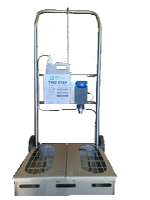
Case Study 1 | Reduced Risk of Cross Contamination
Summary
A food plant processing company experienced an outbreak of Listeriosis and put a program in place to
prevent the transfer of the micro-organisms by creating an SSOP for drain cleaning.
Further investigation revealed that the employees shoes where spreading the contamination throughout the facility.
Challenge
How can the company reduce the chances of spreading the pathogen by workers traveling between different departments within the facility?
Solution
The Company invested in Two Step Sanitizer units that could be positioned at entryways between departments. This allowed them to easily apply a sanitizer directly onto the soles of the shoes as they enter critical processing areas.
Results: Swabbing the bottoms of the workers shoes both before and after application of the sanitizer revealed a significant reduction in viable micro-organisms on the soles of the workers shoes. Repeated applications upon each entry into controlled areas of the plant reduced the cross contamination to acceptable levels.
Case Study 2 | Dry food processor
Summary
An almond processing company sold its almonds to a large well known food processor. The food processor required the almond supplier to sanitize the soles of all workers shoes going into the packaging areas of the plant. This required the workers to step into containment matts with a solution of sanitizer before they could enter the packaging area.
Challenge
The addition of this requirement meant that the baths needed to be checked multiple times daily to ensure that there was a residual sanitizer in the bath. In addition, the employees where dragging excessive moisture into the processing areas from these baths which also created a slip hazard.
Solution
The Company invested in Two Step Sanitizer units that could be positioned at entryways between departments. This allowed them to easily apply a sanitizer directly onto the soles of the shoes as they enter critical processing areas.
Results: Swabbing the bottoms of the workers shoes both before and after application of the sanitizer revealed a significant reduction in viable micro-organisms on the soles of the workers shoes. Repeated applications upon each entry into controlled areas of the plant reduced the cross contamination to acceptable levels.
Case Study 3 | A cereal manufacturing facility
Summary
A cereal manufacturing facility knew that their sanitation program would be stronger if they could control the chances of cross contamination when employees and outside contractors were entering and exiting the plant. Their opinion about using foot baths was that dragging water into a dry area not only causes moisture retention, but also created a slip hazard.
Challenge
How could the company add sanitation protocols to the soles of the employees shoes without installing entryway sanitizing
systems to all of its doors and dealing with the hazards related to wet floors?
Solution
The Company invested in Two Step Sanitizer units that could be positioned at entryways into the facility. This allowed them to easily apply a sanitizer directly onto the soles of the shoes as they entered.
Results: Swabbing the bottoms of the workers shoes both before and after application of the sanitizer revealed a significant reduction in viable micro-organisms on the soles of the workers shoes. Repeated applications upon each entry into the plant reduced the cross contamination to acceptable levels.
The floors remained dry as the small amount of rapidly drying sanitizer did not track out on the floors.